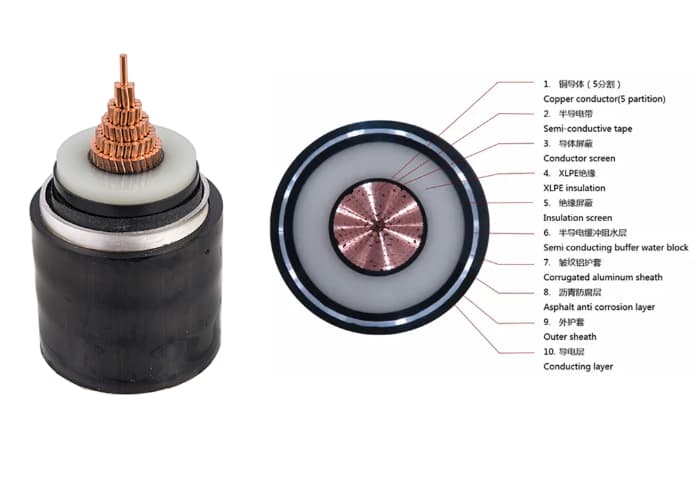
With the continued growth of global energy demand, High voltage cable as an important part of power transmission, its technological development and the application of more and more attention. 400kV high voltage cable as high voltage cable representative, in the transmission of energy it plays a fundamental role. In this document, We will discuss in detail the technical parameters, structural features, laying and maintenance of 400kV cable, future development trends, the manufacturers, prices and other aspects.
1. 400kV Underground Cable Specification
1)400kV cable Rated voltage and current load
Rated voltage of 400kV underground cable, and its current load is related to many factors, as the cross-sectional area of the cable, the tension, insulation material and so on. In general, the current load of 400kV high voltage cables is more than 1000A, and can even exceed 2000A. For example, Denmark in the 1970s 1990 laid 400kV electrical cables, the current rating of 825A, while Dosense Cable's standard rated capacity of high voltage electrical cables up to 1600MVA, the current is 2309A.
2)Conductive and insulating materials
High voltage cables mainly use copper or aluminum as a conductor and an outer layer of insulating materials.. Copper is the preferred material for cable conductors due to its good electrical and thermal conductivity.. However, taking into account the cost factor, Aluminum is also widely used in high voltage cables. Regarding isolation, cross-linked polyethylene (XLPE) It is the preferred material for the insulating layer of high voltage cables due to its excellent temperature resistance and mechanical resistance.. For example, XLPE cable 400 kV of Dosense Cable is made with this material.
3)Cable weight and size
Due to the high current and power of the 400kV underground cable, it is necessary to use a larger conductor cross section and thicker insulation, so the whole cable is relatively heavy. In general, one meter of high tension cable 400 kV weighs about 10 kg. XLPE cables 400 kV of Dosense Cable, For example, They have a diameter of 150 mm and a total weight of 2.440 tons.

2. In second place, The structural characteristics of the 400kV cable
1)Driver structure
The conductor of high voltage cables 400 kV mostly adopts multi-wire structure to improve the conductivity and mechanical strength of the cable. For example, Dosense Cable adopts copper braided cable of 2500 mm². Besides, Some cables also use closed-structure round stranded wire to improve the cable's electrical performance and resistance to external interference..
2)Insulation and shielding
Insulation is a key component of high voltage cables, Its performance directly affects the electrical performance and operational safety of the cable. XLPE material has become the first choice for high voltage cable insulation due to its excellent temperature resistance and mechanical strength.. At the same time, to further improve the electrical performance of the cable, It is also necessary to establish a shielding layer outside the insulation layer. For example, XLPE cables 400 kV of Dosense Cable are shielded from external interference by a radial laminated jacket consisting of a polyethylene outer jacket and a copolymer coated aluminum tape with a fixed joint.
3)Coating and waterproofing
The sheath is the outer protective layer of the high voltage cable, and its material is usually fireproof PVC or PE. The main function of the cover is to protect the cable from erosion and external environmental damage. For cables that have to cross water, special waterproof treatment is also required. For example, the cable 400 Dosense Cable's kV uses a lead jacket instead of aluminum tape to prevent water penetration when crossing the bay.
3. laying and maintenance of 400kV high voltage cables
1)Laying method
Methods of laying high voltage cables 400 kV are varied, the most common being laying under direct burial, tunnel laying and trench laying. Direct burial is the cable buried directly in the ground, with a simple construction, low cost advantages, but you have to take into account the humidity of the soil, acidity and alkalinity and other factors in the cable. Tunnel laying consists of laying the cable in a special cable tunnel, can be convenient for maintenance and overhaul, but the construction cost is higher. Trench laying consists of laying the cable in a trench, between direct burial and tunnel laying.
2)Refrigeration system
For high voltage cable 400 kV of great power and capacity, its operation will produce a lot of heat, so it is necessary to ensure the normal operation of the cable through the cooling system. The most common cooling methods are artificial cooling and natural cooling.. Artificial cooling is mainly used in the direct water pipe cooling method, single core cable in water pipe for direct surface cooling. However, This method consumes a large amount of water and energy, and the treatment of cooling water and the environmental impact must be taken into account. Therefore, when choosing the cooling method, it is necessary to take into account the economy and environmental protection.
3)Maintenance and inspection
Maintenance and testing of high voltage cables 400 kV are essential to ensure its long-term stable operation. Since these cables are usually laid underground or in tunnels, direct observation and contact are more difficult, so the use of advanced detection technology is especially important.
3.1)Online monitoring technology
Online monitoring technology by installing sensors on the cable line, collects cable operating data in real time, like the temperature, the current, the tension, partial discharge and other parameters. This data is sent to the monitoring center through the data transmission system, and the operational status of the cable is evaluated and predicted using big data analysis and artificial intelligence algorithms. When an anomaly is detected, The system immediately issues an alarm so that operation and maintenance personnel can solve it in time.
3.2) Local download detection
Local discharge is an early sign of aging and damage of the insulating layer of high voltage cables. Local discharge detection instruments make it possible to capture, analyze and process weak cable discharge signals. This method can detect possible cable faults in advance., providing a margin of time for repair and replacement.
3.3) Infrared thermal imaging technology
Infrared thermal imaging technology uses infrared thermography to measure the temperature of cables without contact, allowing to visually display the temperature distribution on the surface of the cable. Comparing the temperature difference between different areas, it can be determined if there is overheating of the cable and, next, analyze possible causes of failure.
3.4)Periodic inspection and maintenance
Plus online monitoring and detection technology, Periodic manual inspection and maintenance of high-voltage power cables is also essential. 400 kV. Inspection includes whether the cable appearance is intact, if the joints and terminals are tight, whether the insulation layer is aging, etc. Detected problems must be treated and repaired in time to prevent the fault from spreading..

4. the future development trend of 400kV cable
4.1) Application of new materials
With the continuous progress of materials science, The application of new materials in high voltage cables will be broader. For example, nanomaterials, superconducting materials and self-healing materials, etc. These materials have great potential to improve cable performance, reduce energy consumption and extend service life.
4.2) Smart and digital
Intelligence and digitalization are an important direction for the future development of high-voltage cables. Intelligent monitoring, Early warning and maintenance of cable systems are achieved through the introduction of IoT, big data, artificial intelligence and other technologies. At the same time, digital twin technology will also provide strong support for design, cable simulation and optimization.
4.3) Environmental protection and sustainability
Environmental protection and sustainability are important factors that cannot be ignored in the development of high-voltage cable technology.. In the future, high-voltage cables will pay more attention to the use of environmentally friendly materials, will reduce energy consumption and minimize the impact on the environment. At the same time, recycling and reusing waste cables will also become a research hot spot.
4.4) Transversal integration and innovation
The development of high voltage cable technology will no longer be limited to the energy industry itself, but will have a series of fields for deep integration and innovation. For example, combined with smart grid, the microred, distributed energy and other emerging technologies, to promote the intelligence and flexibility of power transmission and distribution; combined with smart cities, intelligent transportation and other fields, to provide strong support for the intelligent improvement of urban infrastructure.
4.5) Standardization and internationalization of high voltage cables
With the acceleration of global energy interconnection, The trend towards standardization and internationalization of high voltage cables is increasingly evident. The International Electrotechnical Commission (the) and other international standards organizations play an important role in promoting the development of technical standards for high voltage cables, performance testing methods, safety regulations and other aspects. While following international standards, Countries are also formulating corresponding national and industrial standards according to their own actual situation to ensure the quality and safety performance of cable products..
Standardization not only helps reduce technical barriers and costs in cross-border projects, but also promotes exchanges and cooperation in cable technology between different countries and regions. By sharing technical achievements and experiences, Countries can jointly improve the technical level and application ability of high-voltage cables.
4.6) Comprehensive optimization of cable systems
In the design and operation of high voltage cable systems, Comprehensive optimization has become an important line of research. This includes optimal routing of cable lines, increasing transmission capacity, improving operational efficiency and synergy with other network equipment.
Optimizing the routing of cable lines makes it possible to reduce transmission losses and improve the reliability and economy of the electricity supply. At the same time, the use of advanced transmission technologies and equipment, such as high-capacity converter stations and flexible DC transmission technologies, can further improve transmission capacity and operational efficiency. Besides, the cable system needs to achieve synergies with other network equipment, such as transformers and switching stations, to ensure the safe and stable operation of the entire network.
4.7) Respond to the challenges of extreme weather conditions and natural disasters
With the intensification of global climate change, Extreme weather conditions and natural disasters have become an increasingly significant threat to high-voltage cable systems. To improve the strength and responsiveness of cable systems, It is necessary to adopt a series of measures.
First of all, Geological and climatic conditions and other natural factors must be fully taken into account in the design and construction of cable systems., and appropriate laying methods and protective measures must be selected. For example, Better waterproof materials should be used for cable sheathing in flood-prone areas., and in earthquake-prone areas, the seismic design of cable supports and joints must be reinforced.
In second place, establish a perfect emergency response mechanism, including the formulation of emergency plans, the development of emergency drills and the reserve of emergency materials and equipment. In case of natural disasters or emergencies, The emergency response mechanism can be activated quickly to take effective measures to reduce losses and restore power supply as soon as possible.
4.8) Talent training and technological innovation
The development of high voltage cable technology cannot be separated from the training of professionals and the promotion of technological innovation. Universities and research centers must strengthen cooperation and exchange with electricity companies, and jointly cultivate talents with professional skills in design, manufacturing, operation and maintenance of high voltage cables. At the same time, Enterprises and research institutes are encouraged to increase investment in research and development to carry out innovative research and application practice of high-voltage cable technology.
Regarding technological innovation, you have to focus on research, the development and application of insulating materials, conductive materials, accessories and equipment for high voltage cables. By introducing new materials, new technologies and new processes and other means to improve the performance and quality level of high voltage cables; at the same time, actively explore the application prospects of high-voltage cables in the smart grid, distributed energy and other emerging areas and development direction.
5. 400kV Cable Conclusion
In summary, the high tension cable 400 kV, as an important part of the field of power transmission, Its technological development and application to ensure the security of electricity supply and promote economic and social development is of great importance.. Us, Dosense Cable, as 400kV Cable Manufacturer Supplier and Exporter, we are willing to provide any support, including price offer and technical service.
